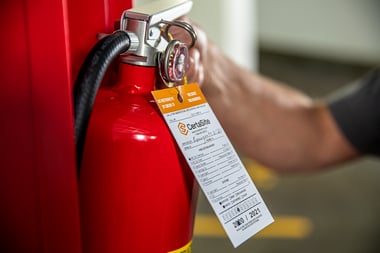
If you have a fire extinguisher in your home or business, do you know how long it’s been there? When was the last time you checked the inspection date?
If your answer is “I don’t know” – you’re not alone. It’s easy to purchase or place a fire extinguisher and forget about it. But, it’s important to keep tabs on extinguishers and make sure they’re functioning so should you ever need them, you know they’ll work.
There are a few things you need to know about your fire extinguisher – what type you have, when each type expires, and what to do if you need to toss it. In this blog, we’ll walk you through everything you need to know so that you can be confident in your fire extinguisher’s maintenance.
When Fire Extinguishers Expire
Fire extinguishers are often only “good” for a certain amount of time. While they may not have a set expiration date, they do need to be tested periodically to ensure that the contents are still functioning properly and the cannister itself isn’t damaged.
There are essentially two types of fire extinguishers: rechargeable and disposable. You can check which kind you have by checking the gauge. Rechargeable ones will read either “charge” or in the green, “overcharge” or “recharge,” and disposable ones will read “full” or “empty.”
If you have a disposable extinguisher, they’re just that – disposable; they cannot be recharged. Extinguishers are filled with a pressurized gas – typically nitrogen or carbon dioxide – that over time can lose pressure and become unusable. Or, if used, the chemical will of course no longer be inside of the unit.
If you have this type of extinguisher, you’ll need to replace it after use or once the chemicals have become ineffective and depressurized – typically at least every 12 years.
Rechargeable fire extinguishers are a little bit different. These also contain pressurized chemicals, but the cannister is designed to be “recharged” or “refilled.” They need to be recharged after every use – even if not all of the contents were used – and also every six years even without use, according to the National Fire Prevention Association (NFPA).
Recharging works by completely depressurizing the extinguisher, cleaning all of the parts thoroughly, installing a new valve, refilling with the active agent and re-pressurizing the unit. A trained professional should recharge any extinguishers.
How to Tell if an Extinguisher is Expired
Now you know when fire extinguishers need to be replaced – but how do you tell if it needs to be replaced or recharged sooner than expected?
One of the best things you can do is a visual inspection of your extinguisher to ensure the gauge is in the green area. If it’s in the red, it indicates the extinguisher is in need of a recharge or it has been overcharged. If you use a fire extinguisher to put out a fire, you will of course need to replace it if it’s disposable or recharge it if it’s rechargeable. But, another important aspect to keep track of is the condition of the extinguisher.
If a cannister is dented or the tamper seal or pin is missing, it needs to be replaced immediately, as there is a risk of explosion. Remember, the contents are under pressure, and so any damaged fire extinguishers need to be removed promptly to an area far away from people.
Additionally, maintenance inspections should be done on an annual basis by a certified fire and life safety company. While inspections by you as the consumer are great, professionals can look with a trained eye to identify any potential issues with any extinguishers.
They can also conduct hydrostatic testing, which tests the integrity of the extinguisher’s cylinder, to make sure it’s safe. During this test, a fire extinguisher is filled above its pressure rating with water, and then the professional can monitor to see if the pressure drops at all. If it does, that indicates the fire extinguisher needs to be replaced.
If any issues are found with an extinguisher, a professional can make sure it’s addressed promptly or that the extinguisher is disposed of properly if required.
What to Do with Expired Extinguishers
Your fire extinguisher is expired or damaged – now what?
If it simply needs to be recharged, then you should contact a professional fire and life safety company like CertaSite to recharge it and conduct an inspection to ensure it’s good to go.
If the extinguisher is disposable or damaged, then properly disposing of the unit is critical. Fire extinguishers with any contents remaining inside should never be thrown in the trash, as they contain hazardous, pressurized chemicals. Instead, fire extinguishers should be taken to your local hazardous waste location or a local fire department. If you’re taking one to the fire department, call ahead to ensure that they receive expired extinguishers.
Not only is improper disposal of fire extinguishers bad for the environment and dangerous – there can also be a fine depending on where you live. Be sure to utilize one of the other options instead.
If your fire extinguisher is completely empty of any chemicals, then it may be able to be thrown away in your normal trash. You should test the unit by releasing the pressure in an open area and letting it sit out in an open area for several days, to make certain all of the pressure is released. When in doubt, ask your local fire department or trash company about disposal.
Hire Professionals You Trust
When it comes to fire extinguishers, the last thing you want is for them to not work when you need them most: during a fire.
To make sure you never have to go through that, make sure you hire professionals you trust to inspect any extinguishers at your business or office. By hiring the right company, you’re not only protecting your property – you’re also protecting your people.
At CertaSite, protecting your people is what we do best. Learn more about our fire and life safety services at www.certasitepro.com.




